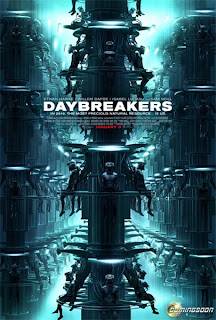 I have seen two great vampire movies: "Daybreakers" and "Let the Right One In." Of the two, I thought Daybreakers was better. Here is why.
I have seen two great vampire movies: "Daybreakers" and "Let the Right One In." Of the two, I thought Daybreakers was better. Here is why.Daybreakers had a few twists that made it interesting. Unlike practically all other vampire stories, in Daybreakers, the vampires are in the majority and running civilisation, while humans are scattered in hunted bands.
A subtler, but more interesting, twist is that the vampires do not change internally when they become vampires. Vampire-hood is brought on by a parasitic disease, so that nothing happens to the victim's faculties, soul or conscience. In other vampire worlds, the turned vampire is anywhere from a completely unrecognizable to seriously twisted version of the original human. In the Buffy world, for instance, many personality traits are retained, but the vampire has no conscience. This leads to a range of reactions, where some vampires take pleasure in the damage and pain they inflict on humans, but most of them are just hunters out looking for their next meal.
In Daybreakers, most of the vampires accept the situation, some with a hint of remorse, others with relish. The protagonist, Ed Dalton played by Ethan Hawke, is so conflicted about the situation that he eventually stops drinking human blood altogether, at the danger of becoming emaciated. In Daybreakers, the vampires do not die from starvation, at least not immediately, but rather turn into a creature like a giant bat.
There is a political undertone to this situation. The vampires retain the full mental capability and moral outlook that they had as humans, yet, when it comes to survival, most of them goes with the flow. If Bromley must lock up humans in a facility, keep them barely alive, and milk them for their blood; if they must fund the military to hunt down and wipe out the last human resistance; if the police must taser, imprison or even kill the poor weaklings that did not make it and are turning into vile bats, then so be it.
These twists make the movie interesting, and it is well done on top. As one small sign of the thoroughness of the world, consider that since vampires do not reflect in mirrors, these high-tech ones use video-cameras to view their own image. With twenty-first century technology, the traditional vampire weaknesses, such as not being able to withstand the sun, is easily overcome. It is not really clear if vampires are stronger, which is another facet I liked. When the characters are fighting with even 19th century technology, there is no reason strength should be an important advantage. (The humans use crossbows in Daybreakers, presumably because they do not have resources to make gunpowder).
Many users call the movie horrible, including one companion I watched the movie with. Let the Right One In got better reception by critics. It has an impressive 8.5 score in its IMDB user rating, where Daybreakers only gets 7.1 (still not bad). Why is this?
I believe it is because Let the Right One In is not really a vampire movie. To enjoy Daybreakers, you must accept the vampire theme. Let the Right One In, on the contrary, is a pretty traditional story about a young, isolated boy, Oskar, who needs to overcome his nemesis. It is a story told countless times. The movie could have worked equally well if his new friend, Eli, was different for any other reason than being a vampire, such as a religious outcast or part of a family of career-criminals. Sure, there are some scenes that play on Eli being a vampire, including a tense moment when Eli and Oskar is lying in bed together, Oskar half asleep. Yet, these scenes are not critical to the overall story. In Daybreakers, the vampire theme is central.
I could have done without a gratuitous explosion or three, but overall, I think Daybreakers adds wonderfully to our vampire folklore.




